SOUTH DAKOTA SOYBEAN LEADER
2024 Summer Check-In
Soy Industry News
3 Farmer-led Efforts to Promote

Soy-based Nutrition
Farmers and Firefighters Join Forces to Eliminate Forever Chemicals
Hungry for Truth: Empowering the Role of Women in Agriculture

New soy-based fire suppressant available –see full story on page 18. Summer Issue 2024 A publication of the South Dakota Soybean Association

FOR WE LIVE BY FAITH, NOT BY SIGHT. II CORINTHIANS 5 : 7 BELIEVE YOU CAN.
President Kevin Deinert, Mount Vernon
First Vice President
Chad Schooley, Castlewood
Second Vice President Drew Peterson, Salem
Secretary Tanner Hento, Avon
Treasurer Brent Greenway, Mitchell
Directors
Chad Nelsen, Viborg
Dan Nigg, Sisseton
Jesse King, Toronto
Jeff Thompson, Colton
Andy Weisser, Roscoe
ASA Corteva Young Leaders
2022-23 Jeff Kloucek, Tabor 2023-24 Ross Tschetter, Bridgewater 2023-24 Riley Schoenfelder, Parkston
Industry Representatives
Kari Vander Wal, South Dakota Soybean Processors
Joe Schefers, Bayer Crop Science
Terry Schultz, Mustang Seeds
Travis Bunde, Raven Industries
Jeff Behrens, Pioneer
American Soybean Association
Brandon Wipf, Huron
Jordan Scott, Valley Springs
Paul Casper, Lake Preston
Editor/Design Director
Mariah Kessler, SD Soybean Communications Director
South Dakota Soybean Leader is published four times a year by the South Dakota Soybean Association, 5000 S. Broadband Lane, Suite 100, Sioux Falls, SD 57108 Phone: 605-330-9942. For address corrections contact South Dakota Soybean Leader at 5000 S. Broadband Lane, Suite 100, Sioux Falls, SD 57108. www.sdsoybean.org | sdsa@sdsoybean.org
Comments and statewide news articles should be sent to the above address. Advertising space reservations must be made by the first of the month preceding publication. In consideration of the acceptance of advertisement, the agency and the advertiser must, in respect of the contents of the advertisement, indemnify and save the publisher harmless against any expense arising from claims or actions against the publisher because of the publication of the content of the advertisement.
PRESIDENT’S OUTLOOK
By Kevin Deinert, President of the South Dakota Soybean Association
The excitement of a new crop year is here, and with it, the joys of doing what us farmers love to do. While Mother Nature may not always be cooperative, we prepare for another year in the fields with the anticipation of raising a bountiful crop. But with that, nothing says South Dakota like a change in weather to start the crop year. From droughts to floods, the scenery and conditions never seem to sit still, but like us farmers always do, we change with it to meet the challenges head on. Just like my young children, the weather is sure to bring surprises (sometimes not good ones too!).

KEVIN DEINERT
SDSA President
While springtime has given us some unanticipated challenges on the farm, here at SDSA, we continue to work on issues that have been in our crosshairs for quite some time. The Farm Bill has been our target as of late with some chatter that the bill may come to the forefront this year. We continue to advocate for a robust and comprehensive Farm Bill that includes increased support of Title I funding, the protection/enhancement of crop insurance, and increased funding for trade promotion programs such as the Market Access Program and Foreign Market Development. We remain in close contact with our congressional delegation and they continue to lean on our ag groups to help with a comprehensive Farm Bill. You may have caught some of that news when Senator John Thune and Ranking Member of the Senate Ag Committee John Boozman held a roundtable at ASA Director Jordan Scott’s farm to hear what was on the minds of our ag groups. [That discussion was] A testament to their commitment to reach out and hear what our concerns are.
While the busy winter schedule of SD Soybean is behind us, we look forward to events that are coming up this summer. If you didn’t catch some of the great content from our Shop Talks this winter, be on the lookout for dates this summer. From transition planning, market outlooks and updates from staff working with our national representatives, there is plenty of great information to take in. Also, we hope to catch you at other great events happening this summer and, as always, information on our summer happenings can be found at sdsoybean.org.
As we make our way through the muddy spring and into summer, I hope you find joy in the place we call home: South Dakota. And as long hours give way to long days, I pray that you take a moment to marvel at what God has laid before us humble farmers. I pray that you stay safe and while my 4-year-old would advocate for mud year-round, I hope that you too find the joy of being able to play in the dirt.
Kevin Deinert
Advertising Inquiries
Garrett Gross, AGE Media (605) 251-6370 | garrett@agemedia.pub www.agemedia.pub
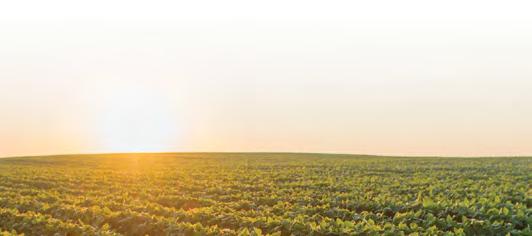
Summer Issue 2024 SDSL 3
Paying checkoff does not automatically make you a member of SDSA. SDSA has membership dues.

4 Summer Issue 2024 SDSL Summer Issue 2024 Volume 13 Number 2 3 President’s Outlook 5 Letter From the Chairman 6 Soy Industry News 9 Letter from the Executive Director 10 3 Farmer-led Efforts to Promote Soy-based Nutrition 12 Producer Shop Talks 13 South Dakota Farmer Adam Krause Uses Social Media to Promote Agriculture and Connect with Community 16 Value in Change: SDSU Leads Expansive, Multimillion-Dollar Conservation Project 18 Farmers and Firefighters Join Forces to Eliminate Forever Chemicals 20 Hungry for Truth Ambassador Pairing: M.B. Haskett Chef, Michael Haskett, Takes on Todd Hanten's Farm 22 Hungry for Truth: Empowering the Role of Women in Agriculture 24 Hungry for Truth: Recipe 26 Trade Talks: South Dakota Soybean Leaders Reflect on Importance of Exports 28 SDSU Team Advances in Global Hult Prize Contest 30 Cultivating Leaders: South Dakota's Soybean Genesis Leaders Program 32 Unlocking the Power of Soybeans: Introducing SD Soybean's New Curriculum 34 Biodiesel
Paving the Way for Next-generation, Low-carbon Biofuels A public a tion of t he S ou t h Dakota S oybean As so ci at io n SO U T H D A K OT A S OY B E A N L E A D E R SDSL
(Still)
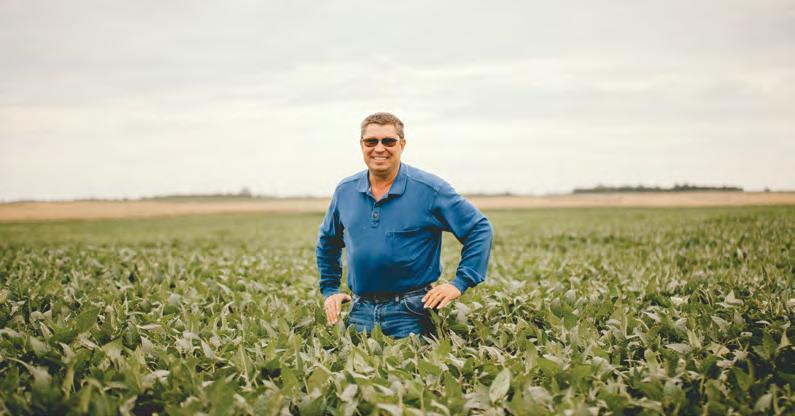
LETTER FROM THE CHAIRMAN
By David Struck,
As the planting season winds down, spraying season ramps up, and we get wrapped up in the day-to-day rigors of farming, it is easy to forget about marketing, lose track of market trends and miss short-lived pricing prospects. It is time for us to complete old crop sales and seize new crop opportunities. Please keep an eye out for rallies in the market to lock in some profitable sales. The markets can pivot back and forth rapidly, especially when there are weather extremes domestically or abroad. Also, be aware that a black swan event, whether caused by nature or man, can impact the market tremendously. Having some profit already locked in helps to weather those events.
As the sprayers roll, please be mindful of your local weather conditions. A good resource for free, accurate, and detailed weather information while spraying is the SDSU MESONET weather app at climate.sdstate.edu. I recommend that you download it to your phone. MESONET collects and displays real-time weather data. Wind speed, temperature, humidity, dew point, soil temperature; it is all there. It even provides potential inversion layer guidance. MESONET has local weather stations to serve you throughout a large part of South Dakota.
We are always looking for new uses of soybean meal and oil to drive demand for our product. One of the latest uses recently developed through research partially paid for with soybean checkoff dollars is SoyFoam™ TF 1122, a firefighting foam. Most of the firefighting foams used by fire departments today contain cancer-causing agents and are very slow to break down in the environment. In many instances, hazmat teams have to clean up after the existing foams are used to save buildings.
The new soybean-based product has been certified biodegradable and received GreenScreen Gold certification. GreenScreen Certified® is a standard that promotes the use of preferred, safe chemicals in products and manufacturing. SoyFoam™ is very safe for use by firefighters and the military. It can even be used in building sprinkler systems.
I recently accompanied three local volunteer firefighters on a trip to Dalton, Georgia, to witness, personally use, and evaluate SoyFoam™. There were also firefighters from several states, including the New York Fire Department. All firefighters were pleased with the product's performance and anxious to try it in their local departments. What impressed them the most was how safe and easy SoyFoam™ is to use and that it is made from a crop grown by farmers.
SoyFoam™ is now commercially available. The SD Soybean Checkoff will provide a container of SoyFoam™ to several fire departments across South Dakota. It is truly a product that has come from field to fire. SoyFoam™ is estimated to consume approximately 12 million bushels of soybeans annually.
Thank you for your dedication to growing soybeans and driving innovation for a sustainable future. Your hard work supports our markets and fuels advancements to ensure a thriving atmosphere for generations to come.
DavidStruck
David Struck Chairman of SDSRPC
Summer Issue 2024 SDSL 5
INVESTING CHECKOFF DOLLARS
Chairman of SDSRPC
DAVID STRUCK, Chairman of SDSRPC
South Dakota Soybean Visits Washington, D.C.
South Dakota soybean farmers Paul Casper, Brandon Wipf, Tanner Hento, Jordan Scott, and South Dakota Soybean Executive Director, Jerry Schmitz, met with Representative Dusty Johnson, Senator John Thune, and staff from Senator Mike Rounds’ office.

SDSU Students Explore the New Frontiers of Agriculture in Houston
A group of SDSU students visited Commodity Classic in Houston, Texas. Many Agronomy and Precision Ag Club members were able to go on this trip thanks to funding assistance from the Minnesota Soybean Growers Association and the South Dakota Soybean Checkoff.
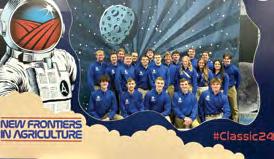
A Successful Soy100
Over 100 producers plus a large group of SDSU students came together for Soy100 on Thursday, March 4, in Brookings, S.D. Naomi Blohm served as the keynote speaker on marketing and economic trends. Other topics included increasing yields, soybean production trends, and climate outlooks. Afternoon breakout sessions focused on pest and management options and soil health. Soy100 hosted a great opportunity for producers to discuss important topics to prepare for the upcoming season.

SDSRPC Sponsors Awards at the South Dakota
SDSRPC Director David Iverson presented the Fiber and Oil Crop Production Proficiency Awards, sponsored by the soybean checkoff, at the South Dakota FFA Convention.

6 Summer Issue 2024 SDSL INVESTING CHECKOFF DOLLARS Soy Industry NEWS
Fun-filled Farm Education at Ag Day!
In celebration of National Ag Week, the South Dakota Soybean Checkoff proudly sponsored Ag Day at the Washington Pavilion, an event designed to educate children and families about agriculture in our state. SD Soybean staff Valerie Willson and Maggie Vander Laan enjoyed two days of teaching kids about soybeans and the different products they can find in them.
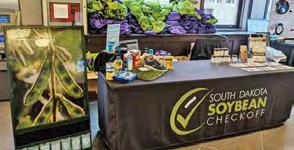
Commodity Classic
South Dakota Soybean farmers attended Commodity Classic in Houston, Texas, to participate in meetings and learn the latest in technology in the agriculture industry.
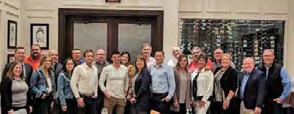

The South Dakota Soybean Association will be sponsoring attendees for the South Dakota Soil Health School, August 26-28, 2024 in Huron, SD. Those interested must be members of the South Dakota Soybean Association. For more information, please contact the office at (605) 330-9942 or email Johnna Ringkob at jringkob@sdsoybean.org.
ARx adjuvants, micronutrients and starter fertilizers are hand-selected and built by Agtegra, specifically for Agtegra farmers. A shortened combination of Agtegra and Prescription, ARx products are researched and tested locally so your trusted advisor can confidently prescribe an ARx product that fits your farm or field.
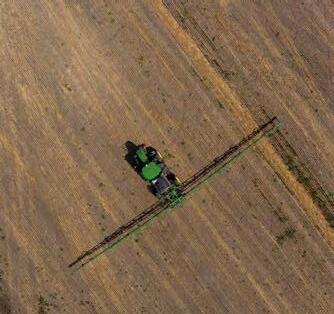
ARx starter fertilizers and micronutrients are formulated and blended right here in South Dakota at our Prescription Agronomics facility in Ipswich.
Summer Issue 2024 SDSL
Products custom built for Agtegra farmers. Learn more at www.agtegra.com/arx

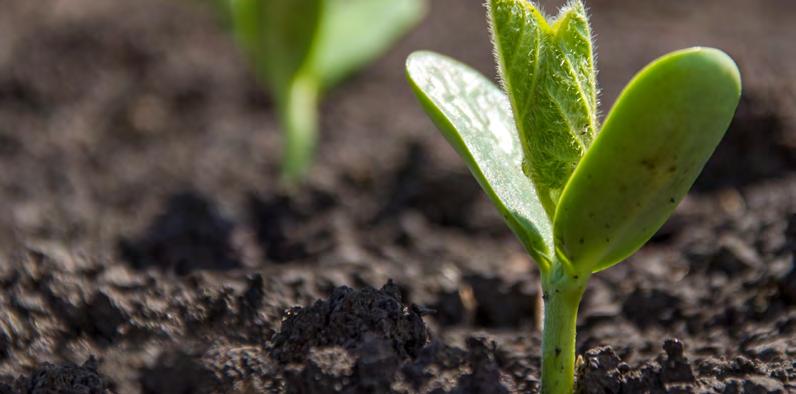
LETTER FROM THE EXECUTIVE DIRECTOR
By Jerry Schmitz, Executive Director of South Dakota Soybean Research and Promotion Council & South Dakota Soybean Association
American farmers are phenomenal at rapidly increasing supply when the world signals a need for more food, fiber, fuel and other goods derived from farms and ranches. American agriculture is the quintessential example of capitalism. Farm and ranch families work hard to produce crops and livestock and then rely on the law of supply and demand to drive prices that sustain and enhance their livelihood. The key to sustainable farm income is finding a balance between supply and world demand.
Rather than leaving demand to chance or relying on government officials who are often influenced by many varying interests, farmers and ranchers have taken the initiative to control their own destiny by personally investing in research, education and promotion of their home-grown products through commodity checkoffs. Like many successful businesses, they invest in product development to achieve the best efficiencies, research to create new and better products for customers and promote their products to inspire interest and drive demand for the quality products they produce.
Farmers often ask what the return is on the dollars they pay into the checkoff. In accordance with federal legislation that requires independent evaluations of the soybean checkoff, a leading University recently performed an economic analysis to measure the effectiveness of soybean checkoff investments. The goals of the study included determining whether soybean checkoff activities increased the consumption and production of soybeans and soy products in domestic and foreign markets and measuring profitability against the cost of the checkoff to determine the return on investment.
The study concluded that as a result of checkoff investments, overall export demand for soybean meal and oil grew by more than 16% over five years. Return on investment over the same period was $12.34 for each farmer checkoff dollar invested. The highest return, $18.18 per dollar invested, came from demand-enhancing research. That type of research helped to develop soy-based products such as concrete and asphalt preservatives, adhesives, plastics, lubricants, tires and the new firefighting foam that fire departments are clamoring for.
So, if the return on investment is $12.34 for each dollar invested, why isn't the soybean price per bushel far higher? The simple answer is increased production (supply). When prices for soybeans climbed, farmers recognized the market signals and planted more acres. Advances in seed, cultural practices, crop protection products and equipment allowed us to increase yields at the same time. The State of South Dakota is a prime example of how production has increased. In 1990, South Dakota farmers produced just under 54 million bushels of soybeans. In 2000, South Dakota farmers produced 153 million bushels and last year, 2023, we produced 223 million bushels of soybeans.
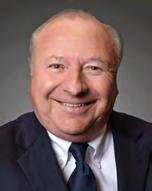
Approximately 60% of all soybeans produced in South Dakota leave the state as whole beans or soybean meal. 95% of the whole beans that leave our state are exported out of the Pacific Northwest (PNW). 36% of the soybean meal that leaves the state is exported out of PNW. That means foreign buyers have a huge impact on South Dakota soybean farmer income.
The SD Soybean Council continually monitors supply and demand and adjusts checkoff investments to ensure a balance that keeps soybean farming profitable. They help educate current and prospective foreign buyers of the high quality and amino acid advantages unique to soybeans produced in South Dakota. They host trade teams on South Dakota farms so buyers can witness the care farmers give to producing the crop. They also visit buyers in their home countries to learn about their needs and cultivate relationships.
Summer Issue 2024 SDSL 9
JERRY SCHMITZ Executive Director of SDSRPC and SDSA
INVESTING CHECKOFF DOLLARS
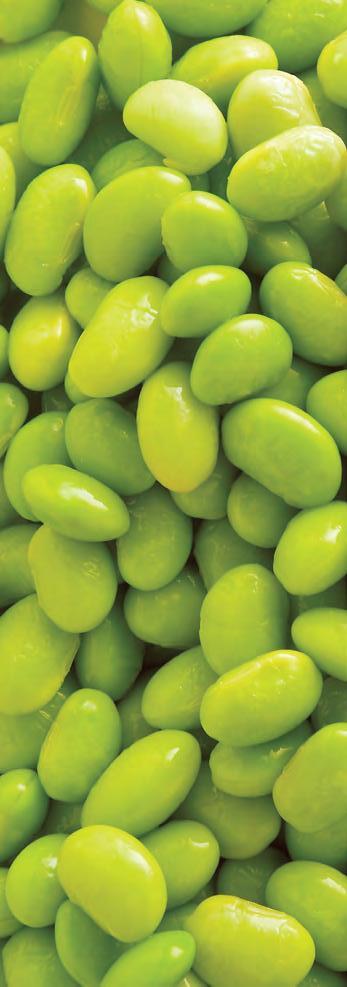
FARMER-LED EFFORTS TO PROMOTE SOY-BASED NUTRITION 3
While most soybeans are used for biofuels, livestock feed and industrial and commercial applications, soy also plays a significant role in human nutrition — both in the U.S. and around the world.
INCREASED CONSUMER FOCUS ON WELLNESS BENEFITS
In recent years, we have witnessed a significant consumer behavioral shift toward increased focus on health and wellness benefits. In fact, a 2024 study published by McKinsey & Company indicated that the global wellness market is currently valued at $1.8 trillion. The U.S. market alone accounts for $480 billion and is growing at an annual rate of 5 to 10 percent.
The South Dakota Soybean Research and Promotion Council sees this as a promising opportunity, considering soybeans' well-documented nutritional value. Continued research and promotion efforts to understand the wellness benefits found in soybeans and position soy as a key player in human nutrition will help support increased domestic and global demand.

10 Summer Issue 2024 SDSL
INVESTING CHECKOFF DOLLARS
THREE CRITICAL FARMER-LED EFFORTS TO PROMOTE SOY-BASED NUTRITION
Farmers are leading the way in promoting the virtues of soy-based nutrition. Three primary ways this plays out on a global scale are through the work of Soy Nutrition Institute (SNI) Global and World Initiative for Soy in Human Health (WISHH); locally, farmers have found great success in accomplishing this objective through the Hungry for Truth initiative.
SOY NUTRITION INSTITUTE (SNI) GLOBAL
Through their checkoff, soybean farmers help fund Soy Nutrition Institute (SNI) Global and its efforts to support research on priority health outcomes. Notable peerreviewed studies associated with SNI Global include the role of soy-based proteins in plant-based diets, soybean oil's effects on cholesterol levels and the impact of soy consumption and skin health.
SNI Global was founded by the farmer-led United Soybean Board (USB) in 2004. Its day-to-day work is guided by a board comprised of leaders within the food and agricultural industries, in addition to a scientific advisory board. Consumers can access a wide array of resources on the SNI Global website to learn more about the benefits of soy, including videos, articles and fact sheets. SNI Global also works closely with health and nutrition influencers to get important information on the benefits of soy in human nutrition into the hands of consumers.
WORLD INITIATIVE FOR SOY IN HUMAN HEALTH (WISHH)
Another important program led by soybean farmers is the World Initiative for Soy in Human Health (WISHH). The American Soybean Association founded WISHH in 2000 to support developing countries around the world in their quest to address food insecurity and satisfy the nutritional needs of a growing population.
WISHH has adopted a unique, innovative strategy of working directly with local entrepreneurs and business owners in emerging markets to serve as a catalyst in advancing soy-based nutrition. This approach supports local economies and increases food security in those regions while boosting demand for soybeans grown in the U.S. WISHH also partners with the checkoff-founded U.S. Soybean Export Council to build strong working relationships and facilitate trade with these emerging markets.
HUNGRY FOR TRUTH
Here in South Dakota, soybean farmers also support soy-based nutrition education and promotion through the Hungry for Truth program. Consumers can find fun, healthy recipes using soy-based products on the Hungry for Truth website and via social media. The initiative also engages popular online influencers and farmer voices to set the record straight regarding food safety concerns and demonstrate the many ways farmers bring a safe, responsibly grown product to the market.
In addition, Hungry for Truth hosts its popular Farm to Fork event each year to bring farmers, consumers, and public officials together to have meaningful conversations about where our food comes from and highlight the benefits of soy in human nutrition.
LEARN MORE ABOUT PROMOTING SOY IN HUMAN NUTRITION
To stay current on ways farmers are advancing the merits of soy in human nutrition, talk to your South Dakota Soybean Research and Promotion Council district director or visit sdsoybean.org.

Summer Issue 2024 SDSL
ALWAYS JUST A CLICK AWAY FROM THE LATEST SOY RELATED NEWS AND UPDATES. STAY UP TO DATE WITH US AT: SDSOYBEAN.ORG SOY TOPICS PROGRAMS & EVENTS NEWS & MEDIA LEGISLATION AND MUCH MORE




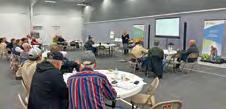
In March 2020, the South Dakota Soybean Association (SDSA) launched a new event called “Shop Talks,” which pivoted our organization to better accommodate the changing needs of the world and our members. While these events have changed, evolved, and improved over the past four years, the general goal has remained the same - Shop Talks aims to expand agricultural expertise and network with fellow soybean farmers. "Shop Talks are our way of connecting with producers throughout the state to inform them about what South Dakota Soybean is doing for them,” said Kevin Deinert, SDSA President. “These events address the major updates and issues facing our state's farmers."
This year’s winter Shop Talks series was hosted in Madison and Yankton. Participants heard from national congressional offices about the major issues affecting the agricultural sector. The Farm Service Agency and USDA discussed their farm storage facility loan process. Farm Credit Services of America presented agricultural outlooks on finances and protecting revenue. Legacy Law Firm P.C. talked about protecting land and best practices in transition planning.
SUMMER SERIES
ABERDEEN SHOP TALK
Tuesday, July 30th 9:30 A.M. – 1:00 P.M.
AGTEGRA
908 Lamont Street South Aberdeen, SD 57401

“With a new Farm Bill in the works nationally, it was great to hear what priorities and issues our legislators are tackling,” Deinert continued. “Like many farms across the country, my own farm is entering a period of generational transition. Thus, hearing from people at Legacy Law Firm gave me insight into what to watch and expect as we go through the transition.”
Bruce Haines is the District 1 Director for the South Dakota Soybean Research and Promotional Council and had the honor of attending and being a panelist for both events. “This winter's Shop Talks were very educational and were attended by a great group of community members, fellow ag producers, and industry experts,” Haines explains. “The conversations around our noon lunches were very engaging and entertaining. I hope that if you have not had a chance to attend a Shop Talk, the next time one is in your area, you plan to join the conversation.”
Shop Talks wouldn’t be possible without the support of our generous sponsors, Farm Credit Services of America and Legacy Law Firm P.C. SDSA plans to continue hosting Shop Talk events throughout South Dakota during both the winter and summer seasons.
CHAMBERLAIN SHOP TALK
Tuesday, August 13th 5:30-9:00 P.M.
SOUTH DAKOTA HALL OF FAME
1480 S Main St Chamberlain, SD 57325
12 Summer Issue 2024 SDSL
Audience members ask questions at the Yankton Shop Talk.
Legacy Law Firm presents on family planning in farming.
SOUTH DAKOTA FARMER ADAM KRAUSE USES SOCIAL MEDIA TO PROMOTE AGRICULTURE AND CONNECT WITH COMMUNITY
Adam Krause does not keep to himself. To begin with, the Clear Lake, South Dakota farmer is outgoing. He’s friendly and welcomes the chance to talk about his farm and his family, which he does regularly on social media.
“In the YouTube world and social media world that we live in today, especially my generation, there’s just so many different opportunities to promote yourself, but also promote what you do and how you make a living,” said Krause, in an interview for The Soybean Pod podcast.
Raising soybeans, grains, and pigs, Krause is president of the South Dakota Pork Producers Council, giving him a voice in commodity group governance. But he makes his voice heard in other ways and encourages others to do the same.
“I feel like you can be an influencer and support your industry without being on the board too,” said Krause. “I think just about everybody has a Facebook account, just being able to post that picture with a tractor or a combine in the sunset. I like to post sometimes that it’s not all sunshine and rainbows; I get a barn alarm sometimes at 1:00, 2:00, 3:00 in the morning and you’ve got to go see what happened in the barn. So [I’m] showing not only the beauty of farming and agriculture but the rawness too and the realness of what we do every day.”
Krause, who is to be featured on an edition of The Soybean Pod, posts on his own and also appears on other platforms, such as Ag United of South Dakota’s Adopt a Farmer video series.
“Every month, I make a short 10 to 15-minute video just kind of taking little tidbits of what I did in the month, and another thing of outreach is my cooking show, kind of how I utilize farm products,” he explained. “I try and highlight soybeans using vegetable oil and dairy and pork cuts of course. I do some beef, a little bit of chicken too just being able to just be you, and one: not only be kind of entertaining but to be pretty educational, I think, is a lot of fun as well.”
Krause is a farmer and also an influencer, but he insists it’s the element of fun that keeps people coming back.


Summer Issue 2024 SDSL 13
INVESTING CHECKOFF DOLLARS
Adam and his wife, Taylor, with their two children.
Adam Krause, Clear Lake, S.D. farmer
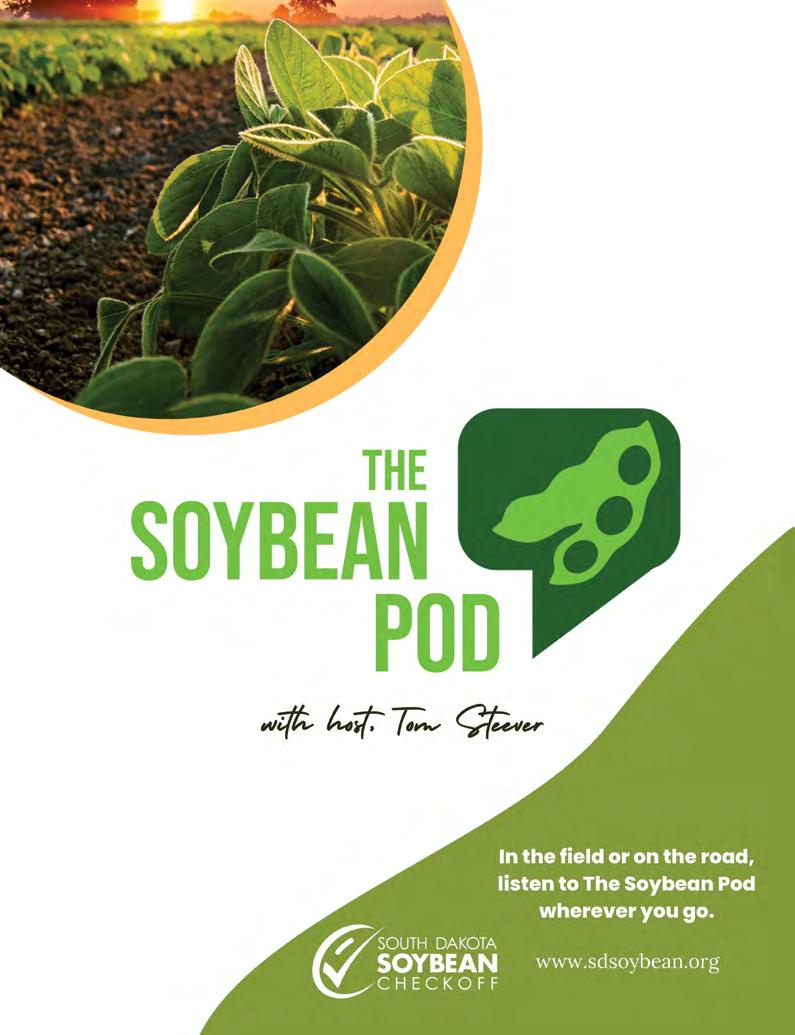


VALUE IN CHANGE: SDSU LEADS EXPANSIVE, MULTIMILLIONDOLLAR CONSERVATION PROJECT
By Addison DeHaven
For the last few years, David Clay's summer routine has stayed pretty much the same. As the weather allows, Clay — along with his team of researchers and graduate students — travels around to corn and soybean fields in eastern South Dakota to take soil measurements. This work, part of a multimillion-dollar project to create more value for farmers in the region, is vital in understanding how conservation practices are contributing to soil health in the face of a changing climate.
But for Clay, this work is nothing new. For the last 30 or so years, the South Dakota State University distinguished professor and South Dakota Corn Endowed Chair in Precision Agriculture has been conducting highly influential work in the field of agricultural research. Time and time again, Clay's research has shown that conservation practices, like reduced or no tillage, nutrient management and cover crops, can improve both agricultural profitability and environmental sustainability.
"These practices create more value for the farmers while reducing the impact on the environment," Clay said. "It's a win-win."
This past winter, Clay’s work received a huge boost when it was announced the United States Department of Agriculture’s Natural
Resource Conservation Service would be investing an additional $25 million to expand the use of conservation practices in the region. For many, adopting these practices would seem like a no-brainer. But in reality, it’s a bit more complicated.
A CHANGE IN PERSPECTIVE
Brennan Lewis is a research associate in SDSU's Department of Agronomy, Horticulture and Plant Science. Growing up in western Minnesota, tilling was by far the most common technique for growing crops. It wasn't until Lewis spent time out in central South Dakota with Dwayne Beck, a former SDSU professor and research manager for the Dakota Lakes Research Farm, that he first saw the value in reduced- or no-tillage techniques.
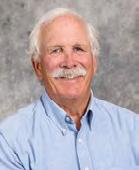
16 Summer Issue 2024 SDSL
DAVID CLAY Professor of Soil Science at South Dakota State University
INVESTING CHECKOFF DOLLARS
Photo provided by the United Soybean Board.
"It can be difficult to really understand the value of these practices until you actually see them in action," Lewis said. "But once you do, the benefits are clear."
Now, Lewis serves as an unofficial spokesman for these practices, helping show farmers around the region their value. The challenge, Lewis has found, is that slight variables can have noticeable impacts on results, which can deter farmers from making the change. What works in central South Dakota — where there is less rain and more drought adaptations — may be different from what works in eastern South Dakota.
"There are different benefits, but the important part is that these benefits are quantified," Lewis said. "Being able to see how these practices actually work can create new perspectives on adopting them."
Despite these challenges, the advantages of the practices are significant. Clay's 2015 research showed that soil carbon levels increased by 24% between 1985 and 2010, resulting in a 73% increase in corn yields. This resulted from a decrease in tillage intensity through the development of specialized farm equipment and improved soybean and corn cultivators.
An increase in soil carbon levels allows for greater water retention, which means less runoff and less impact on surrounding water bodies. It also improves the crop's ability to resist drought as more water will absorb deeper into the soil. Reduced tillage also allows for microbial communities to grow, which fuels the state's pheasant population through an increase in earthworms.
Overall, Clay estimates that increased moisture through better soil management had a net impact of $1.1 billion on South Dakota agriculture in 2012, which was one of the more severe drought years in recent history. Widespread usage of no- or reduced-till techniques could have an even greater impact on the region's economy.
PUTTING RESEARCH INTO PRACTICE
With the new $25 million investment, Clay and his research team believe they can greatly expand the use of conservation practices throughout the region.
"We've experienced firsthand the outpouring of interest in this project as we work one-on-one with farmers in South Dakota," Clay said. "This expansion project will meaningfully scale the adoption of climate-smart farming practices throughout the biofuel producing regions of the U.S. and provide us with the scientific data necessary for full clean fuel market access."
The 2021 American Coalition for Ethanol-led (ACE) Regional Conservation Partnership Project worked to secure farmers’ access to low carbon fuel standard markets through the adoption of conservation practices. The new funding will allow even more farmers to get paid for adopting these practices while creating even more value by utilizing new tax incentives, like the 45Z clean fuel production credit.
"SDSU has been working in the field of soil carbon for over 30 years and is excited, in collaboration with our partners, to extend the project across the 10-state region," Clay said. "This project represents a win-win for farmers and the environment. Farmers benefit from higher yields and greater profits, and the environment
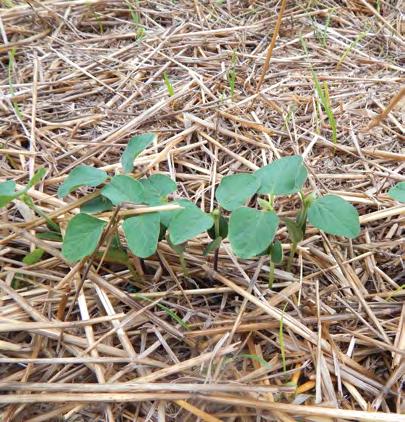
wins by improved soil health and the removal of greenhouse gasses from the atmosphere."
The project currently has more than 10,000 acres in South Dakota under contract, and that number is expected to increase as the project picks up. The new investment will also expand the project into Illinois, Indiana, Iowa, Kansas, Minnesota, Missouri, Nebraska, Ohio and Wisconsin.
SDSU's role in the project will remain largely the same. Clay and his team of researchers and graduate assistants will serve as the technical lead and will measure and quantify the soil health and reduced emission benefits resulting from the adoption of these practices. The data will then be used to calibrate models and address gaps that currently prevent farmers in the Midwest from accessing these lucrative clean fuel markets and tax credits.
The economic potential of these practices is hard to ignore. According to ACE, there is potential to remove over 2,679,843 metric tons of carbon dioxide from the atmosphere per year, equivalent to taking 596,346 cars off the road annually. This could result in over $500 million per year in value from clean fuel markets and the 45Z tax credit.
The potential long-term benefits, as ACE notes, also should not be overlooked. The USDA estimates U.S. farmers could store an additional 180 million metric tons of carbon per year in their fields through the adoption of conservation practices. This could reduce U.S. carbon emissions by as much as 14%.
Partners on this project include the South Dakota Corn Utilization Council, Dakota Ethanol, Cultivating Conservation, the South Dakota Soybean Research and Promotion Council, and the South Dakota Corn Growers Association.
Summer Issue 2024 SDSL 17
Photo provided by the United Soybean Board.

FARMERS AND FIREFIGHTERS
JOIN FORCES TO ELIMINATE FOREVER CHEMICALS
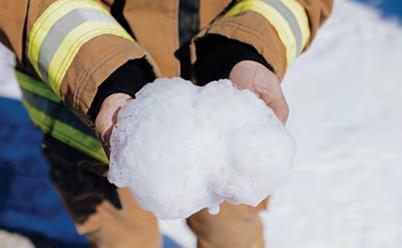

Firefighters will soon have a new, environmentally friendly tool at their disposal with SoyFoam™ TF 1122, a biodegradable fire suppressant made from soy flour. This innovative product promises effective fire suppression while being significantly more eco-friendly compared to traditional foams.
Matt McCranie, a farmer from Claremont, S.D., and a volunteer firefighter, was among a group of South Dakota soybean growers who traveled to Dalton, Ga., to witness and test SoyFoam™ firsthand. “We were able to demo it ourselves in a couple of scenarios and get some first-hand use of testing SoyFoam™,” McCranie shared. “It worked as a foam should. There was nothing that jumped out to me that it wouldn’t perform how we need it to when we need to use a foam of some sort. It’s Class A/B foam and it’ll work on your Class A, your combustibles and then your B, liquids, so we were able to use it in both scenarios down there to put out fire with it.”
McCranie highlighted the environmental benefits of SoyFoam™. “SoyFoam™ is definitely more eco-friendly. It is 84 percent bio-based; a large portion of that is made from soybean flour. And the biodegradability of it is going to make it way more eco-friendly than anything we’re using now,” he said. “You get the same and just as effective firefighting and foaming properties of a fire foam in this SoyFoam™, and not the harmful effects for firefighters or the environment.”
In the firefighting community, McCranie, like many volunteer firefighters, is always ready to respond to emergencies. “Just kind of stop what you’re doing and go respond to the incident,” he explained. “[A volunteer] kind of always has to be prepared for anything, really, at the drop of a hat.”
Joining McCranie on the trip to Georgia was Andy Weisser, an Edmonds County farmer, South Dakota Soybean Association board member, and assistant chief of the Roscoe, South Dakota, Volunteer Fire Department. Weisser shared his enthusiasm for SoyFoam™ and its benefits. “Yeah, what a trip,” Weisser exclaimed about the demonstrations of Cross Plains Solutions’ SoyFoam™ TF 1122. “It was fun, it was neat. It was neat to learn about this stuff.”
Weisser explained the advantages of using a soy-based fire suppressant. “First of all, it’s natural; it’s a soy product, it’s what we grow. Why not utilize something that we grow, something that’s biodegradable, that’s, to me, very safe to put [fires] out?
I mean, it’s kind of a neat little circle,” he said. He emphasized that SoyFoam™ effectively quadruples the amount of water the department takes to a fire. “Like if you use normal water on a fire, you’re going to cool down the heat of a fire; you’re going to knock down the flame, but it can flare back up,” he said. “SoyFoam™ will coat it, blanket it, keep the fire knocked down for a longer period of time.”
The current foams used to fight fires are effective but environmentally toxic. In contrast, SoyFoam™ offers a safer alternative. “SoyFoam™ would be a safer product. That is one huge benefit that it has,” Weisser pointed out. “We’re used to this PFOS and the PFAS foam, which would be a Class A, ordinary combustible, and a Class B, flammable liquids [fire
18 Summer Issue 2024 SDSL INVESTING CHECKOFF DOLLARS
suppressant]. So, SoyFoam™ is really kind of a neat situation, because it does actually take care of a Class A and Class B fire.”
SoyFoam™ TF1122, developed by Cross Plains Solutions, is the first and only firefighting foam GreenScreen Certified® at the Gold Level.
SoyFoam™ is 100% free of intentionally added perand polyfluoroalkyl substances (PFAS) and is made with no fluorine.
SoyFoam™ is certified ready biodegradable by the Organization of Economic Cooperation and Development and is 84% biobased through the U.S. Department of Agriculture BioPreferred® program.
David Struck, Chairman of the South Dakota Soybean Research and Promotion Council, commented on the significance of SoyFoam™. "Seeing SoyFoam™ in action, it's evident we've found a remarkable solution. Not only does it effectively suppress fires, but it's also a game-changer for our environment. As a farmer, knowing that soybeans are being utilized in such an impactful way is incredibly gratifying. With SoyFoam™, we're not just protecting firefighters; we're championing sustainability and safety."
Another benefit of SoyFoam™ for the soybean industry is its use of soy flour, which helps find new demand streams for the increased soybean meal crush. Cross Plains Solutions estimates that current applications of SoyFoam™ TF 1122 have the potential to use the protein from 12 million bushels of soybeans, with new uses beyond firefighting applications on the horizon.
The U.S. Environmental Protection Agency (EPA) reports that PFAS is found in water, air, fish, and soil at locations across the nation and the globe. Exposure is linked to several adverse health effects, including certain cancers, thyroid dysfunction, changes in cholesterol, and small reductions in birth weight. Mitigating forever chemicals through soy-based products can create a real impact, not only for the safety of first responders but also to maintain the integrity of local communities’ soil health, air quality, and drinking water.
Alan Snipes, Managing Partner of Cross Plains Solutions, expressed pride in their partnership with U.S. Soy. “We are proud to partner with U.S. Soy to launch this breakthrough firefighting foam for use by fire departments across the nation. Our manufacturing plant in Georgia is ready to produce SoyFoam™ now, so fire departments can ask their suppliers to offer it. We also see demand for numerous additional applications, ranging from canisters to sprinkler systems.”


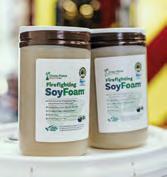
Protect your firefighters and support farmers by bringing SoyFoam™ to your community. Contact South Dakota Soybean to learn more 605-330-9942.

Summer Issue 2024 SDSL 19
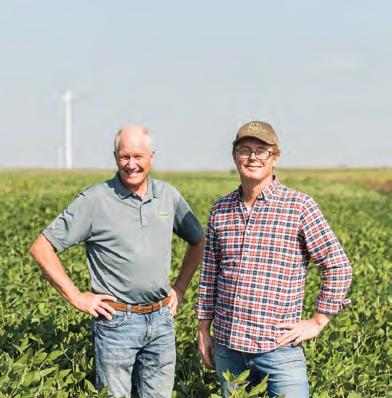
Having open conversations about food and farming with South Dakotans and the farmers who grow it is what we do. In fact, that’s what Hungry for Truth is all about.
We had an exciting opportunity to connect local restaurant M.B. Haskett Chef, Michael Haskett, with Todd Hanten, a soybean, corn, and cattle farmer from Goodwin, to chat about farming, the impactful work farmers do, and much more. Below, Michael shares his learnings from his farm visit.
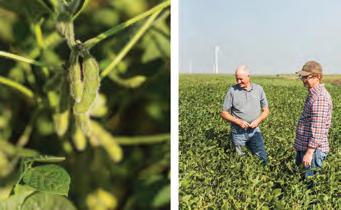

HUNGRY FOR TRUTH AMBASSADOR PAIRING: M.B. HASKETT CHEF, MICHAEL HASKETT, TAKES ON TODD HANTEN'S FARM
By Michael Haskett, M.B. Haskett owner and chef
As a chef whose profession is centered around food, I always look forward to opportunities to speak with the people who produce what we eat. When Hungry for Truth offered me an opportunity to visit Todd Hanten’s farm near Goodwin, SD for a tour and discussion about Ag production in our food system, I was happy to accept the invitation. A big part of being a chef is to understand how ingredients are produced, who grows them, and then tell that story to our customers. Because having something to eat is so vital to survival, it is chefs’ and other food service professionals’ duty to inspire appreciation for the food system, especially in people not directly involved in food production. Because everyone needs to eat, we are all part of the same global food system.
On the second to last day of August, the corn is taller than most large pickup trucks. As one drives north on Interstate 90 between Dell Rapids and Watertown, the rows of corn, alfalfa, and soybean plants have filled in the fields to make the landscape look like that familiar, green, checkerboard quilt of mid-summer in eastern South Dakota. When we arrive at Todd’s Farm, we are greeted by two stout retrievers, one still with some youthful rambunctiousness and curiosity, the other, interested, but only mildly, and moves slowly and deliberately, unphased by the arrival of visitors. With the dogs alerting our presence, Mr. Hanten steps out of his house to meet us wearing a dark green South Dakota Soybean Checkoff polo. He is friendly, and after some introductions, he takes us first to see some of his equipment.
We gravitate naturally to the behemoth and sparkling new combine sitting in the yard, stoically waiting for the dryer late summer weather to ripen this year's crop. After proudly pointing out the fairly obvious fact that it is neither a completely green nor red combine (the farmers reading this will understand), Todd brings me to the cab, starts the machine, and begins pointing out all of the most up-to-date technological systems on board. These sensors and computers (parts of what are called precision planting systems) collect data, that will help the farmer understand which parts of his land are most productive, identify areas that may need some sort of intervention or amendment, and will inform him where in their field how densely he should plant a particular crop next year. Todd asks me if I want to drive the machine, and while I am excited to learn how to drive a combine, I want my first experience to be on a much older (and drastically less expensive) combine, kind of like learning how to drive on a manual transmission.
After checking out a few more pieces of equipment, we take a short drive through the feeding lot for his cattle, and then over to an area he farms about two miles away from his house. The reason Todd brings us here is so that we can see the effects that a combination of poor soil
20 Summer Issue 2024 SDSL INVESTING CHECKOFF DOLLARS
quality and drought conditions have on a crop of corn. The part of the field we walk into is at the bottom of a hill, near the oil road, and where a bridge passes over a small stream. While most of the field is lushly green and the plants are tall with easily visible ears growing on them, this is an area about the size of a soccer field where the plants are stunted, earless, and turning brown. It is quickly obvious that these plants will not recover from the stress of not enough water and hot temperatures before the growing season ends.
Todd points out that while most of the soil in this field has some sand in it, this part of the field has very sandy soil and is lacking in organic matter. When soil is very sandy like this, rainwater drains quickly and on hot summer days dries out in no time, making it very hard for water-hungry plants like corn to thrive. We talk about some possible solutions to this problem. Todd can add organic matter, such as spreading manure from his cattle and keeping as much plant material in the ground by implementing low-till or no-till practices.
When soil is disturbed by tillage, vital nutrients that plants need to grow are lost in the atmosphere; the structure that decaying plant material gives the soil breaks down much more rapidly and results in compaction. This also makes soil less capable of holding moisture, which then results in plants underperforming or incapable of producing a crop at all. I ask Todd if he uses cover crops or perennial plantings such as alfalfa to help build health into his soils, and I am happy to hear that
he does. As part of his crop rotation, Todd has used a variety of cover crops such as rye, lentils, peas, turnips, and daikon radish in the fall to help loosen soil texture, fix particular nutrients that successive crops will need, and improve the microbiology living in the soil.
We drive briefly to another field where the soybeans are growing well, but the pods are a little small. Todd says that a good soaking of rain will plump the beans right up, and we both hope that some showers come before too long.
When we have finished the tour of the fields, we return to his house and start to talk more about the economic and social aspects of what being a row crop farmer in South Dakota entails. Todd explains how the checkoff system works. When a farmer sells their beans on the market, half of one percent of the sale is collected and goes to the United Soybean Board (USB). The USB uses those funds for three primary functions; research, promotion, and education.
The money spent on research goes to things such as testing and developing seed genetics that improve yields in specific and changing environments and climates. Research money also helps develop new products from soy such as soy-based proteins or cooking oils. The promotion dollars go to marketing campaigns both here in the States, as well as negotiating and promoting the international trade of soybeans. The education dollars go into programs that help both the farmer, who learns more about the best production methods on the farm, and the consumer,
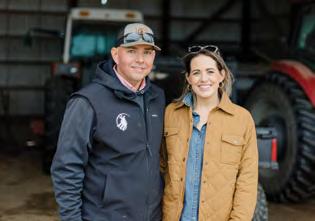
who is presented with information such as nutritional and health facts about soybeans.
As we wrap up our conversation, I ask Todd how farmers are dealing with the many challenges of being a modern row crop grower in this global market of food production. He says that programs like Soybean Checkoff assist growers in advocating for the work they do, developing new markets, and promoting sales of soybeans so the farmer can earn a fair price for all of the hard work they do. He also points out that there are many ag-related associations and trade groups like the South Dakota Soybean Council that help farmers navigate hard times and natural disasters. These groups also help growers find counseling for emotional and mental health challenges and when struggles on the farm become too much for a farmer to deal with on their own.
Todd leaves me with this - even though food production requires so much time and physical labor, it is an incredibly rewarding vocation. Growing food connects a person with the land and their neighbors. A farmer must be in tune with changes in the weather, the seasons, and soil conditions. They have to keep up with what markets are doing and what customers are demanding. Good farmers help their neighbors and communities stay productive and healthy. And they have to make decisions that will sustain their business, their crops and livestock, and their family. Todd Hanten says that of his life as a fourth-generation farmer on his great grandfather’s homestead “It’s not work at all, it’s fun.”

Ambassador Program
Connecting and giving real people access to a real South Dakota farm to learn, observe, ask questions, engage with farmers, and see first-hand how South Dakota farming operations go round.
Read all our Ambassador Pairing stories online at hungryfortruthsd.com/ambassador-program
Or scan QR code
Summer Issue 2024 SDSL 21
To find more Hungry for Truth Ambassador farm visits, go to hungryfortruthsd.com
Cattle rancher, Calli Williams, learns the ropes of crop farming and soil sampling with agronomist and farmer, Jeff Kloucek

Happy National Women's Month! Learn about the experiences, hardships, and contributions of women in agriculture. Today, we're acknowledging one particular woman leader.
Meet Heather Beaner, a trailblazing figure in agriculture. Her accomplishments and dedication are a testament to the incredible work women do in this field.
Heather has been at the forefront of sustainable farming practices. She pioneered innovative techniques that have changed the way we approach agriculture. We aim to shed light on the important role of women in agriculture through Heather's story.
Q: CAN YOU SHARE YOUR JOURNEY INTO THE WORLD OF AGRICULTURE? WHAT INSPIRED YOU TO PURSUE A CAREER IN THIS FIELD?
A: I grew up on the farm but left to go to college and then law school, ending up in the Air Force as an attorney in the JAG Corps. It was never really my intention to come back and take over the farm until my Mom’s health turned bad a decade later and my Dad was at the point of needing to make a decision about the operation since my only sibling wasn’t involved in the farm. Plus, I had met my future husband while home on leave and he was a solid South Dakota boy, so I knew my place was back home on the farm.
Q: AS A WOMAN IN AGRICULTURE, WHAT UNIQUE PERSPECTIVES OR EXPERIENCES DO YOU BRING TO THE INDUSTRY?
A: Women are natural caregivers and nurturers. That gives us a unique perspective on things and we analyze situations from a different angle than most men. My time in the Air Force and as an attorney also gave me a certain skill set and problem-solving approach that is useful in business and in my work as a board member for the various Ag boards I serve.
Q: COULD YOU HIGHLIGHT SOME OF THE CHALLENGES YOU'VE FACED AS A WOMAN IN AGRICULTURE AND HOW YOU'VE OVERCOME THEM?
A: When I first came back to the farm, especially without having any experience in production agriculture or even an Ag-related degree, I had to play catch-up on a fairly steep learning curve My Dad worked hard over the first few years to teach me what I needed to know, but being a woman didn’t impact that. What did was when I would go to the seed or chemical meetings and be the only female in the room. Everyone assumed I was a farmer’s wife who tagged along, not the actual farmer. Salesmen and agronomists would stop by or call and ask to speak to my husband.

EMPOWERING THE ROLE OF WOMEN IN AGRICULTURE
I was always silently amused at their reactions when I replied that I was the farmer and if they wanted anything to do with our operation they had to deal with me.
Q: IN YOUR OPINION, HOW HAS THE ROLE OF WOMEN IN AGRICULTURE EVOLVED OVER THE YEARS, AND WHAT POSITIVE CHANGES HAVE YOU WITNESSED?
A: There are so many more women in Ag now than a decade ago when I first came back, especially in agribusiness. I’m no longer the only woman in the seed or chemical meetings! What I’ve enjoyed witnessing is that it doesn’t seem to matter to most people if the person they are dealing with is a man or woman, as long as they know what they are talking about and are good at their jobs.
Q: WHAT SPECIFIC CONTRIBUTIONS DO WOMEN MAKE TO THE AGRICULTURAL SECTOR, AND HOW DO THESE CONTRIBUTIONS IMPACT THE INDUSTRY AS A WHOLE?
A: Women are the link between the old farmers of yesteryear and the future generation. We took over from our grandfathers and fathers or started our own operations, and now we are raising the next generation of farmers. We work hard but also do the extra, like raising a family, in a way that only women can. After all, we are great multitaskers!
Q: ARE THERE ANY FEMALE FIGURES IN AGRICULTURE WHO HAVE INSPIRED OR INFLUENCED YOUR CAREER? HOW HAVE THEY MADE A DIFFERENCE?
A: I appreciate any woman who is willing to put in the long hours, efforts towards learning, and extra work, all while being a minority in the industry just to grow their operation or become better at their job. And don’t forget about the traditional “farmer’s wife;” without the women behind the men all these years, many farms would never have survived. My grandmothers and my Mom were farmers’ wives and they were some of the strongest people I know.
Q: HOW DO YOU BALANCE THE DEMANDS OF A CAREER IN AGRICULTURE WITH OTHER ASPECTS OF YOUR LIFE, AND WHAT ADVICE DO YOU HAVE FOR OTHER WOMEN NAVIGATING SIMILAR CHALLENGES?
A: Much like busy women everywhere, we have to learn to say no. As a woman in production agriculture, which is a rare thing to start with, I get many requests for my time and service. I have to choose things where I can be of the greatest service but not compromise my time needed for the farm. Plus we have to get creative: my son rides around in the equipment with me quite a bit and we turn some of my board trips into family vacations.
22 Summer Issue 2024 SDSL
INVESTING CHECKOFF DOLLARS
Q: WHAT INITIATIVES OR PROJECTS ARE YOU CURRENTLY INVOLVED IN TO PROMOTE WOMEN'S PARTICIPATION AND SUCCESS IN AGRICULTURE?
A: I’ve done some mentoring and speaking about women in Ag. I often tell women who are looking to get involved in Ag or service on Ag boards that they need to know what they bring to the operation and their own skills. Don’t do things just because you are a woman, make sure that no matter your gender, people will appreciate what you have to offer.
Q: CAN YOU SHARE A MEMORABLE OR REWARDING MOMENT FROM YOUR CAREER IN AGRICULTURE THAT STANDS OUT AS A PROUD ACHIEVEMENT?
A: When my Dad was finally able to officially retire (which farmers never really do of course) because I could run the operation myself; and when the farm became profitable enough to support my husband leaving his job in town to come home to farm with me.
Q: HOW DO YOU ENVISION THE FUTURE OF WOMEN IN AGRICULTURE, AND WHAT STEPS DO YOU THINK ARE CRUCIAL TO FOSTERING CONTINUED PROGRESS AND INCLUSIVITY?
A: Women can function in every facet of agriculture, but we have to be careful that we don’t push our way in just for the sake of diversity. We need to know what we are doing too. Truly accomplished individuals in agriculture are hard workers, innovative, strong, and dedicated to taking care of the land and animals God gave us, and when we are women too, it is even better!
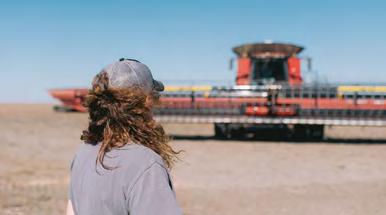
EMPOWER THE WOMEN IN AGRICULTURE
The remarkable stories and insights shared by Heather highlight the invaluable contributions of women in agriculture. Heather's journey, from implementing sustainable farming methods to mentoring the next generation of female farmers, showcases the multifaceted roles women play in agriculture.
Her dedication, resilience, and innovations in sustainable farming practices demonstrate the pivotal role women play in securing our food supply and promoting agricultural sustainability. The empowerment and recognition of women in agriculture is vital for gender equality and the future of agriculture.
Start supporting and empowering women in agriculture today. We can pave the way for a more inclusive, equitable, and sustainable agricultural sector that benefits us all.

GRAIN MANAGEMENT SOLUTIONS GRAIN MANAGEMENT SOLUTIONS
Recently GSI announced that they are retiring some products. The AD Link platform and remote monitoring will no longer be supported after December 15th, 2024.
2 options for replacing your BULLSEYE system are:
AgroLog is a complete automation system which will control aeration fans for you. The system monitors temperature, moisture, CO2, Grain Level and puts this information where you need it most, on your laptop and smartphone.
Grain Trac utilizes either existing or new temperature cables. Grain Trac allows the user to interact with his grain system remotely on his laptop or smartphone and sends alerts if the grain goes out of condition. A typical Grain Trac system would cost around $2,900. Call today for peace of mind and harmony in your home! 1 2

Summer Issue 2024 SDSL 23 TSGC@TSGCINC.COM | (800) 438.8367 TSGCINC.COM DANIEL WINKOWITSCH PRESIDENT

COCONUT PINEAPPLE YOGURT POPSICLE
Yield: 8 Popsicles | Provided by: Hungry For Truth | Prep Time: 5 Hours


Enjoy the essence of summer with these Coconut Pineapple Yogurt Popsicles. Combining the tropical flavors of coconut and pineapple with the creamy texture of yogurt, these popsicles offer a delightful treat. Dairy products, including yogurt, are crucial in providing essential nutrients like calcium and protein. Dairy cattle consume meal from 1.9 million bushels of South Dakota soybeans annually. The impact of South Dakota's dairy industry on the state's economy is significant. According to the International Dairy Foods Association, the industry generated a total economic impact of $4.85 billion in the past year and created 14,700 jobs in the state.
INGREDIENTS
1 Cup Canned Light Coconut Milk
2 (5.3oz) Containers Non-Fat Pineapple Yogurt
1 Cup Frozen Pineapple
3/4 Teaspoon Coconut Extract
1 Tablespoon Sugar
INSTRUCTIONS
1. Combine all ingredients into a blender and blend until smooth.
2. Pour the mixture evenly into molds of your choice.
3. Freeze popsicles overnight before eating.
24 Summer Issue 2024 SDSL INVESTING CHECKOFF DOLLARS
Find more recipes at hungryfortruthsd.com

Now’s the time to sign up to enter the 2024 Yield and Quality Contest.
Why should you participate? You can win cash prizes of up to $2,000, plus bragging rights all year long! And your data helps us compile best management practices for today and tomorrow.
MASTER CLASS
Previous contest winners recognized for achieving 100 bushel or greater will be automatically placed in the Master Class in all subsequent years.
MAIN CLASS
Entrants 18 years and older not participating in the Youth Class.
YOUTH CLASS
The Youth Class is open to participants age 13-21, with entrants age 18-21 having the option of participating in the Main Class or Youth Class.
Entrant age determined on January 1 of the contest year. (Applicable for Youth Class)
Youth Class 4 Categories: 0-1 Irrigated, 0-1 Non-irrigated, 2-3 Irrigated, 2-3 Non-irrigated

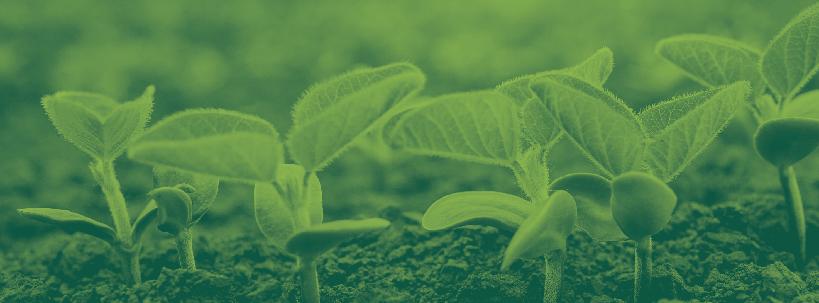
ENTER TODAY!
If you have questions call 605.330.9942 or visit
Sponsored by Managed by
www.sdsoybean.org.
ENTRY FORM DUE AUGUST 31
TRADE TALKS: SOUTH DAKOTA SOYBEAN LEADERS REFLECT ON IMPORTANCE OF EXPORTS

With more than half of all soybeans grown in the U.S. reaching a final destination outside the country, it's no surprise that trade is a significant area of focus for the South Dakota Soybean Research and Promotion Council. Even as we look toward ways to keep value in-state through increased processing capacity, livestock development, and growth in the biofuels category, securing demand abroad will continue to help support value for soybeans grown in South Dakota.
SOYBEAN TRANSPORT INFRASTRUCTURE
Transport infrastructure is critical to soybean trade, and South Dakota farmers have funded several key projects through their checkoff in recent years to support greater overall efficiency when delivering their soybeans to markets around the world. Notable investments of soybean checkoff dollars include a dredging project to boost barge capacity on the Mississippi River as well as research, analysis and design at Port of Grays Harbor to improve logistics in the Pacific Northwest (PNW).

THE IMPORTANCE OF RELATIONSHIPS AND PRODUCT QUALITY
These sorts of infrastructure improvements don't go unnoticed by buyers in foreign markets. "When we go overseas to our customers, they talk about infrastructure as a prime factor in purchasing U.S. soy," said South Dakota Soybean Research and Promotion Council District 6 Director Todd Hanten, who farms in the Goodwin area.
Hanten reiterated the prioritization the South Dakota Soybean Research and Promotion Council continues to place on transport logistics concerns in order to remain competitive on the global market. "Getting our products there when they need them is something that is important to all of agriculture — not just soybeans," he said.
While it may seem like most purchasing decisions are made solely based on price and availability, the importance of relationships and product quality cannot be understated. That's why soybean farmers in South Dakota are focused on fostering connections with international buyers through their checkoff.
South Dakota Soybean Research and Promotion Council has sponsored trade tours to several emerging markets as well as hosted buyers on reverse trade tours to the U.S. in recent years, providing farmers and other industry leaders with opportunities to forge relationships and showcase the premier product they grow here in South Dakota.
26 Summer Issue 2024 SDSL INVESTING CHECKOFF DOLLARS
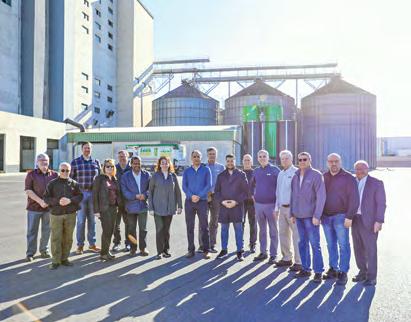
"What comes out of (trade missions) is to build those relationships that tie the soybean they are buying to the actual producer," said Claremont-area farmer Michael McCranie, District 7 Director for the South Dakota Soybean Research and Promotion Council.
In McCranie's view, trade tours represent a unique opportunity for farmers to connect with buyers and discuss the many factors that contribute to the superior quality of soybeans grown in South Dakota. He likened this experience to a restaurant chef coming out from the kitchen to check in on the dining experience of their patrons. "We're proud of our product, and we want to showcase it to our customers," he said.
Both McCranie and Hanten pointed to the outstanding quality of soybeans grown in South Dakota as something that sets their product apart on the global market. They are also quick to tout the sustainable, responsible production practices exhibited by South Dakota farmers as a distinguishing factor with international buyers.
"It's actually one of the first questions they ask," said Hanten "'How sustainable are you?' and 'How can we differentiate your product as more sustainable than that of other countries?'"
"Sustainability is always a big topic, and getting to be a bigger topic all along," confirmed McCranie. This increased interest in how soybeans are produced in South Dakota makes reverse trade missions that bring international buyers here all the more important. "What we'll do is host trade teams in the U.S. and get those same customers on our farms," he said, "and we actually show them the way we farm and the way we do things."
Being able to emphasize increased yield-per-acre efficiencies and discuss soil management practices such as no-till and min-till farming and growing cover crops goes a long way toward asserting the sustainability narrative of soybean farmers in South Dakota.
BOOSTING DEMAND IN EMERGING MARKETS
Soybean farmers are also actively engaged in supporting growth in emerging markets around the world through their checkoff. "We
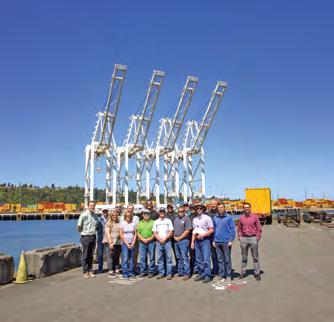
want to make sure we have good, diverse markets for the U.S. farmer," explained Salem-area farmer Dawn Scheier, District 3 Director for South Dakota Soybean Research and Promotion Council.
In addition to her role with South Dakota Soybean, Scheier has also served in leadership roles with both U.S. Soybean Export Council (USSEC) and World Initiative for Soy in Human Health (WISHH). As a result, she is a staunch advocate for a strategic, collaborative approach to boosting global demand for soy. "USSEC is trying to build preferences for U.S. soybeans, working in both emerging and mature markets," said Scheier.
She and McCranie both participated in a checkoff-sponsored trade mission to Morocco last winter. This delegation met with Moroccan leaders who are focused on improving efficiencies in feed processing and building up the nation's livestock infrastructure to accommodate shifting food preferences.
"Morocco is the fifth largest economy in Africa," said Scheier. "It's a market we need to be in and one where we've got really good potential for growth." She praised the role USSEC's Soy Excellence Center plays within the region in terms of supporting growth in beef, dairy, poultry (laying hens and broilers), aquaculture and more.
GET INVOLVED IN SUPPORTING GLOBAL SOYBEAN DEMAND
Opportunities abound for South Dakota soybean farmers to participate in checkoff-sponsored efforts to support trade and export activities. These include See For Yourself tours to learn more about transport infrastructure in the PNW and trade tours to new and emerging markets, not to mention reverse trade tours hosted in South Dakota. For more information on getting involved, talk to your district director or visit sdsoybean.org.
Summer Issue 2024 SDSL 27


SDSU TEAM ADVANCES IN GLOBAL HULT PRIZE CONTEST
By South Dakota State University Marketing and Communications
Abusiness plan developed by four South Dakota State University students — to manufacture biodegradable, singleuse plastic bags out of soybean hulls — has earned them a chance to advance in an international contest with the next stop being Nairobi, Kenya.
The SDSU students are among 360 teams that advanced out of 10,000 teams entered in the global Hult Prize competition, which is considered the Nobel Prize for college students, according to team member Hunter Eide of Gettysburg. Other members are Nicole Schilling, of St. Peter, Minn.; Kylie Rosenau, of Blue Earth, Minn.; and Samuel Hadacek, of Mount Solon, Va.
Ultimately, there is only one prize to be earned, and it’s a big one — $1 million. But the students and their advisers are already amazed at how far they’ve come in the prestigious competition that went well beyond their normal coursework.
“SDSU is in the top 3.6% in the world, and that’s really extraordinary,” said Rebecca Bott-Knutson, dean of the Van D. and Barbara B. Fishback Honors College. The competition draws more than 100,000 young people from more than 100 countries.
“It’s super exciting” to have advanced, Eide said. As part of the next round, the SDSU students were among 40 teams submitting their business proposals at a summit in Nairobi June 7-9. That is among nine cities worldwide where students will compete.
STARTED WITH THE JUSTICE CHALLENGE
The students took on the project while participating in The Justice Challenge, a national, year-long honors experience designed to empower participants with skills in addressing the world’s most wicked problems using systems thinking.
The initiative, funded by the National Institute of Food and Agriculture within the U.S. Department of Agriculture, was led by the Fishback Honors College and SDSU with help from 13 additional partner universities. One hundred participants from more than 20 universities participated in the inaugural year, which focused on food justice.
The international Hult Prize contest was among other opportunities students could pursue to continue leveraging their new skills. Two teams formed from The Justice Challenge — one from SDSU and one from the University of Louisville.
The SDSU students, graduating seniors Eide and Schilling, and incoming junior Rosenau and incoming senior Hadacek, focused their Hult Prize work on their shared appreciation for agriculture.
28 Summer Issue 2024 SDSL INVESTING CHECKOFF DOLLARS
From left, Nicole Schilling, Hunter Eide and Kylie Rosenau and, below, Samuel Hadacek have advanced their business plan to manufacture biodegradable, single-use plastic bags out of soybean hulls to the second round of the international Hult Prize competition.
Samuel Hadacek


BEYOND THE CLASSROOM
The SDSU students will be joined in Kenya by Srinivas Janaswamy, an associate professor in dairy and food science as well as agronomy, horticulture and plant science. He serves on t he advisory board for the students’ proposed company, Agri-Cycle Innovations, and is the source for the product the students envision producing.
Agri-Cycle Innovations' premier product is a biodegradable, non-toxic, single-use plastic, which is made from non-edible parts of soybean plants rather than petroleum, which takes years to break down. Janaswamy said, “We are creating a value addition by upcycling the bio residues. I was impressed when the students contacted me to develop their project based on my research.”
Bott-Knutson said the students’ efforts went well beyond their Justice Challenge online coursework, which some took for credit and others as a co curricular activity. The students kept meeting and digging into more complex issues.
“It’s very rare and very exciting to see a group of students go beyond like this. … That’s some of the real magic behind this group of students. They are so tenacious and so deeply motivated to understand the world around them and to figure out how to make a positive impact on some of our greatest challenges,” she said.
BUSINESS PLAN IN PLACE
Janaswamy is advancing the scientific research behind the business plan and has created a patent-pending process that extracts cellulose from the hulls and adds a solvent to give the cellulose film the same strength as petroleum-based bags.
While he continues to focus on research and development of the technology, the budding entrepreneurs are creating a successful business concept — one that would leverage the $1 million grand prize and venture capital.
Their first step would be marketing to local stores that take a sustainability focus and then expanding to regional outlets.
They project breaking even in the second year as its primary input, soybean hulls, is low cost and abundantly available, Schilling said.
SHORT PRESENTATION
At the Nairobi summit, students will have four minutes to make their presentation. Then there is a two-minute question-andanswer session and two minutes for feedback from judges. Eight teams will be chosen for an extended presentation in Nairobi with one winner chosen.
“In order to be successful, the team must make a compelling pitch for their idea in four minutes or less. This takes teamwork, planning and surgical-like precision in their use of every second” Bott-Knutson said.
The winning team from each summit along with three other startups selected through the Second Chance Round will earn a spot at the Global Accelerator. Those 12 semi finalists will connect with Hult Prize mentors and curricula to refine their pitches and further develop their businesses. In August, they will travel to London to spend two weeks working and learning with world-class experts and coaches.
From that stage, six teams will be chosen to participate in the $1 million finals.
FIRST SDSU TEAM SINCE 2011
This is the 15th year of the Hult competition and the first year for SDSU to compete since 2011, Eide said. The students formed their contest corporation, Agri-Cycle Innovations, in November. Their proposal was submitted in February, and they learned of their success in mid-April.
Eide noted that past Hult Prize winners have come from Ivy League schools, which can be intimidating, but “our success is a testament of what SDSU can do for its students.”
Part of that support is providing travel funds for the students through the SDSU Foundation, Fishback Honors College and the College of Agriculture, Food and Environmental Sciences.
The students have been guided by a faculty advisory team including Barb Heller (entrepreneurship), Bott-Knutson and Janaswamy. Industry advisory members are Kyle Bender, Falcon Plastics, and Dawn Nagel, a Gettysburg farmer.
“We’re excited to make everybody proud in the next round,” Schilling said.
Summer Issue 2024 SDSL 29
SDSU associate professor Srinivas Janaswamy creates plastic-like film from agricultural byproducts in his research lab on campus.
Srinivas Janaswamy
CULTIVATING
LEADERS: SOUTH DAKOTA’S SOYBEAN GENESIS LEADERS PROGRAM
Empowering Soybean Growers with Leadership Skills and Industry Insights
The South Dakota Soybean Research and Promotion Council has partnered with South Dakota Agricultural and Rural Leadership (SDARL), the premier ag leadership development organization in the state, to offer the Soybean Genesis Leaders Program exclusively for soybean growers. Through a series of four one-day seminars, Soybean Genesis Leaders Program is designed to give active members of the soybean industry a deep foundation in leadership skills and industry knowledge, positioning class participants for growth in their operations and careers.
SEMINAR 1
Class 3 (2023-24) of Soybean Genesis Leaders got off to a great start at the first seminar on Dec. 15, 2023, in Sioux Falls. The group gathered at the Raven Industries training center for a seminar focused on leadership and the organizations that support soybean growers, including SD Soybean Research and Promotion Council, SD Soybean Association, American Soybean Association, United Soybean Board, US Soybean Export Council, and World Initiative for Soy in Human Health.
SEMINAR 2

The second seminar focused on the legislative process and was held on Jan. 19, 2024, in Pierre. Class members had a close look at state government and the legislative process, including a visit to the Capitol for a briefing with Governor Kristi Noem and Lieutenant Governor Larry Rhoden. The group had an excellent day in Pierre and a unique opportunity to meet with a variety of people who work together to address the issues affecting the ag economy in South Dakota.

SEMINAR 3
Seminar 3 saw the Genesis Leaders class head to Brookings on Feb. 16, 2024, covering the topics of innovation and forward focus. The group had speakers, tours, and discussions about new and potential uses for soybean products, and the anticipated changes in markets for which producers need to be ready.
SEMINAR 4
The Soybean Genesis Leaders Program concluded on March 15, 2024, in Watertown. With a theme of leadership readiness, program participants were challenged to consider where their next leadership development opportunity might arise. Finally, the group had a graduation ceremony where they received Certificates of Completion from SDARL and SD Soybean.

30 Summer Issue 2024 SDSL
INVESTING CHECKOFF DOLLARS

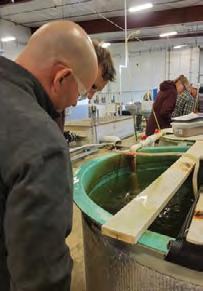

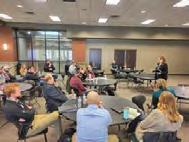
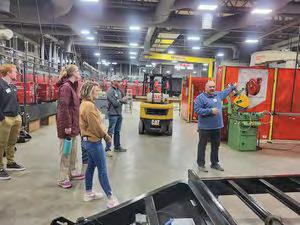
CLASS III GRADUATES
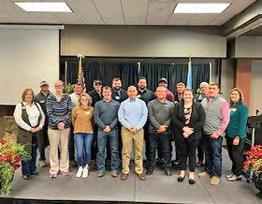
Tyra Bechen, Groton, SD
Trevor Benson, Lyons, SD
Tara Bierman, Northville, SD
Scott Christopherson, Volga, SD
Sarah Engel, Aberdeen, SD
Brent Greenway, Mitchell, SD
Bruce Haines, Mitchell, SD
Colton Hanson, Watertown, SD
Zack Hazel, Baltic, SD
Zach Hefty, Baltic, SD
Braedon Hinker, Pierre, SD
Cody King, Brookings, SD
Jeff Kloucek, Scotland, SD
Dustin Lounsbery, Canistota, SD
Larry Michels, Sioux Falls, SD
Collin Powell, Chamberlain, SD
Connor Powell, Pukwana, SD
Jared Questad, Baltic, SD
Sam Schaunaman, Aberdeen, SD
Chad Stoterau, Sherman, SD
Summer Issue 2024 SDSL 31
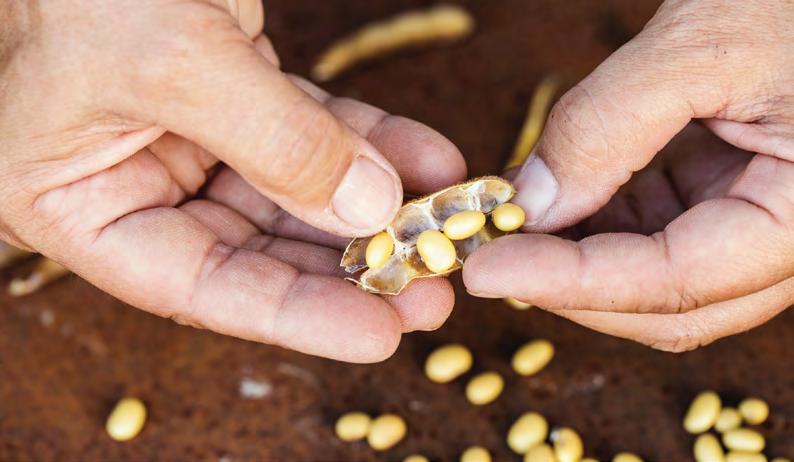
UNLOCKING THE POWER OF SOYBEANS:
INTRODUCING SD SOYBEAN’S NEW CURRICULUM
Soybeans hold immense potential not only in South Dakota fields, but also in South Dakota’s agriculture classrooms. Thanks to the support of the South Dakota Soybean Checkoff, a new agriculture curriculum is set to launch in July for agriculture educators across the state.
This new curriculum places soybeans at the forefront of learning. With ten topics spanning various agricultural pathways, it integrates state standards while offering a fresh perspective on the versatile crop. From exploring soybean composition and diseases, to delving into soy’s applications in aquaculture, food processing, and biofuels production, each lesson promises engaging, hands-on experiences that will resonate with learners across the state.
Within the curriculum, an array of resources awaits educators, offering a comprehensive toolkit for classroom instruction. From detailed guides for teachers to reading materials for students, instructional aids, worksheets, supplementary resources, and
engaging projects, each component is designed to enrich the classroom experience. The curriculum provides a wealth of information in different formats so educators can adapt the topics to their own classrooms and learners.
This curriculum project also includes funding for lab kits, curated to equip teachers with essential materials to implement the ten topics into their agriculture classroom. Each kit includes a copy of the curriculum and the materials for five hands-on labs for up to twenty students. These include a soybean growing lab, investigating soybean meal in rations lab, materials to make biodiesel, soy candles, and tofu.
As this soybean curriculum unfolds its pages to educators this summer and in classrooms across South Dakota this fall, it signifies more than just an educational resource. It shows a commitment to agricultural education in South Dakota and to the students who are the next generation of soybean producers, consumers, and advocates.

32 Summer Issue 2024 SDSL
INVESTING CHECKOFF DOLLARS
Photo provided by the United Soybean Board.

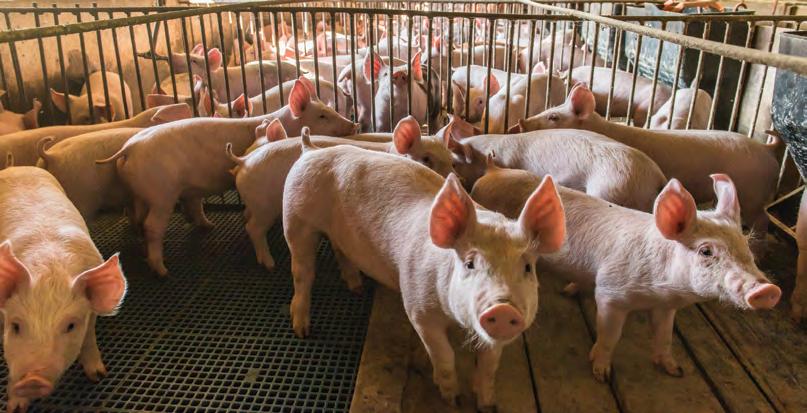
BIODIESEL (STILL) PAVING THE WAY FOR NEXT-GENERATION, LOW-CARBON BIOFUELS
National Biodiesel Day is celebrated on March 18 to commemorate Rudolf Diesel, the inventor of the diesel engine. Diesel’s first engine ran on a farmer-produced feedstock - peanut oil.
“The use of vegetable oils for engine fuels may seem insignificant today,” Diesel said in 1912, “but such oils may become - in the course of time - as important as the petroleum and coal tar products of the present time.”
Diesel’s words ring true today.
For 2023/2024 USDA estimates nearly 13 million pounds of soybean oil (or more than 1 million acres of soybeans) are being used to produce biodiesel to replace petroleum diesel.
As farmers in South Dakota know, the soybean oil market is about to look a lot different with the addition of a new local crush facility. For more than 20 years, biodiesel producers have been building a foundation for what’s coming in a new future of the low-carbon fuels marketplace. But biodiesel’s time is not up according to a panel of experts at the recent Clean Fuels Alliance America conference.
Clean Fuels represents biodiesel, renewable diesel and sustainable aviation fuel marketing and policy efforts. While all three low-carbon fuels can be produced from soybean oil, Midwest biodiesel producers shed light on the evolving landscape of clean fuels during a conference panel.
Gary Lewis, President and CEO of Seaboard Energy, emphasized the pivotal role of biodiesel in laying the groundwork for the industry's growth. He stated, "Biodiesel laid the groundwork for [renewable diesel] and sustainable aviation fuel (SAF), and in many respects, [they] are now raising the profile of biodiesel."
Brad Wilson from Western Iowa Energy noted, "Renewable diesel is better with biodiesel, and biodiesel is better with renewable diesel when you blend the two."
The panel highlighted positive policy changes impacting biodiesel producers. Kerry Fogarty from Incobrasa Industries in Illinois expressed optimism about the conversion of the federal blender's tax credit to a producer credit, which incentivizes domestic production.
"The higher value of the tax credit will be based on the carbon intensity of feedstocks and energy usage, aligning with the industry's efforts to reduce carbon emissions,” said Wilson.
The panelists also underscored the importance of diversification within the biodiesel market. Lewis emphasized the versatility of
biodiesel products, stating, "There is a marketplace for all these different products."
Clean Fuels has recently touted new partners in the marine and railroad industries, announced celebrity endorsement for Bioheat from Donnie Wahlberg and introduced PepsiCo as a new Clean Fuels Alliance America member alongside state associations like South Dakota Soybean.

While the industry is facing uncertainty from EPA regulations on renewable volume obligations and state policies requiring low-carbon fuels, the outlook for soybean oil-based fuels is exciting. As biodiesel continues to evolve and adapt to changing market dynamics, soybean producers should be proud that their homegrown fuel remains a cornerstone of the clean fuels landscape.
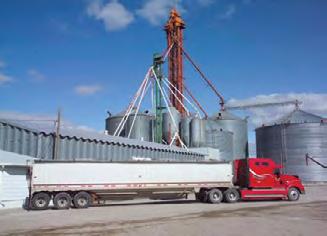
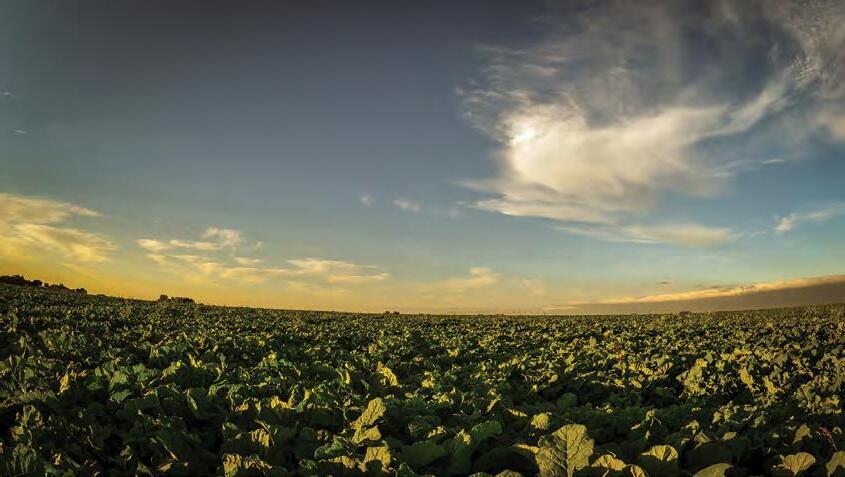


34 Summer Issue 2024 SDSL
INVESTING CHECKOFF DOLLARS
Photo courtesy of United Soybean Board
Rudolf Diesel (18 March 1858 – 29 September 1913) was a German inventor and mechanical engineer who is famous for having invented the Diesel engine, which burns Diesel fuel; both are named after him.



Financial Incentive
To help cover the start-up costs of cover crops, Farmers for Soil Health o ers financial assistance of up to $50/acre over a three-year period.






Exclusive Marketplace
Enrollment in Farmers for Soil Health provides access to an exclusive future marketplace connecting farmers to top-tier supply chain partners that are focused on sustainability.
Technical Advisor
Each state has dedicated on-theground technical advisors to provide research-based information and educational resources to aid in the transition of your field.
 Executive Director
Executive Director
FARMER BENEFITS AND INCENTIVES INCREASE Profitability
TA Per Acre $
Support
Good for Your Land and Your Bottom Line Learn More about Farmers for Soil Health Contact For more information, contact your state’s Technical Advisor by visiting FarmersforSoilHealth.com
Ben
Ph.D. info@farmersforsoilhealth.com
West,
◾ 400+ ag exhibits with the latest equipment
◾ BioZyme Livestock Tent featuring demonstrations and education
◾ Networking Lounge with live music
◾ Educational sessions and Ride & Drive demonstrations
◾ Food, fun, and entertainment activities







36 Summer Issue 2024 SDSL 2024 DAKOTAFEST SPONSORS AUGUST 20–22 , 2024, 9 AM – 4 PM MITCHELL, SOUTH DAKOTA dakotafest.com #Dakotafest24 Visit Dakoatfest.com for $5 tickets, and use promo code LEADER24 at checkout for an additional $2 off the $7 online ticket price. $5
Creating connections in ag




















































































